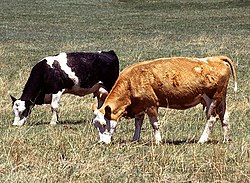You have two cows

"You have two cows" is a political analogy and form of early 20th century American political satire to describe various economic systems of government. The setup of a typical joke of this kind is the assumption that the listener lives within a given system and has two cows, a very relatable occupation across countries and national boundaries. The punch line is what happens to the listener and the cows in the system; it offers a brief and humorous take on the subject or locale.
A newer variant of the joke cycle compares different peoples and countries.
History
[edit]An article in The Modern Language Journal lists the following classical ones:[1]
- Socialism: If you have two cows, the Government takes one and gives it to your neighbor.
- Communism: If you have two cows, Government takes both and then gives you some milk.
- Fascism: If you have two cows, you keep the cows and give the milk to the Government; then the government sells you some milk.
- New Dealism: If you have two cows, you shoot one and milk the other; then you pour the milk down the drain.
- Nazism: If you have two cows, the Government shoots you and keeps the cows.
- Capitalism: If you have two cows, you sell one and buy a bull.
Bill Sherk mentions that such lists circulated throughout the United States since around 1936 under the title "Parable of the Isms".[2] A column in The Chicago Daily Tribune in 1938 attributes a version involving socialism, communism, fascism and New Dealism[nb 1] to an address by Silas Strawn to the Economic Club of Chicago on 29 November 1935.[3]
Richard M Steers and Luciara Nardon in their book about global economy use the "two cows" metaphor to illustrate the concept of cultural differences. They write that jokes of the kind are considered funny because they are "realistic but exaggerated caricatures" of various cultures, and the pervasiveness of such jokes stems from the significant cultural differences. Steers and Nardon also state that others believe such jokes present cultural stereotypes and must be viewed with caution.[4]
Notable variants
[edit]Jokes of this genre formed the base of a monologue by American comedian Pat Paulsen on The Smothers Brothers Comedy Hour in the late 1960s. Satirising the satire, he appended this comment to capitalism: "...Then put both of them in your wife's name and declare bankruptcy." This material was later used as an element of his satirical US presidential campaign in 1968, and was included on his 1968 comedy album Pat Paulsen for President.[5]
Enron scandal
[edit]The economics of the Enron scandal have been a target of the "two cows" joke, often describing the accounting fraud that took place in Enron's finances. Much of the beginning of the joke when used to describe Enron resembles the following:
Enronism: You have two cows. You sell three of them to your publicly listed company, using letters of credit opened by your brother-in-law at the bank, then execute a debt/equity swap with an associated general offer so that you get all four cows back, with a tax exemption for five cows. The milk rights of the six cows are transferred via an intermediary to a Cayman Island company secretly owned by your CFO who sells the rights to all seven cows back to your listed company. The annual report says the company owns eight cows, with an option on six more.[6]
The ending of the joke varies in most interactions. The magazine Wired in 2008 ended the joke with Enron selling one cow to buy a new president of the United States, that no balance sheet was provided with the annual report, and ultimately the public buying Enron's bull.[7] In 2002, Power Engineering ended the joke by announcing Enron would start trading cows online using the platform COW (cows on web).[8]
See also
[edit]Notes
[edit]- ^ New Dealism: You have two cows. The government takes both, shoots one, buys milk from the other cow, then pours the milk down the drain. — Cited in: Lisgar Collegiate Institute. "Vox Lycei 1939-1940".
{{cite journal}}: Cite journal requires|journal=(help)
References
[edit]- ^ George A. Henninger, "In Defense of Dictionaries and Definitions", The Modern Language Journal, January 1944, vol. 28, pp.29-39
- ^ "500 Years of New Words", by Bill Sherk, Doubleday, 1983, ISBN 0-385-17902-2, p. 162.
- ^ "The Class in Political Isms". Chicago Daily Tribune. December 3, 1938. p.12, col.3.
- ^ Managing In The Global Economy, by Richard M. Steers, Luciara Nardon (2005) ISBN 0-7656-1551-7
- ^ ""Pat Paulsen for President" - album info and review". LiveDaily Store. Retrieved 2007-12-18.
...included in this collection: "Two Cows," where the various systems of government are explained with the useful illustration of two cows...
- ^ "360 Environmental". www.360environmental.co.uk. 10 August 2009. Retrieved 1 December 2022.
- ^ Sterling, Bruce. "New and Improved Economic Cow Jokes". Wired. ISSN 1059-1028. Retrieved 2022-11-30.
- ^ "Enron and the Two Cows". Power Engineering. 2002-02-01. Retrieved 2022-11-30.
